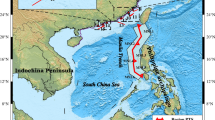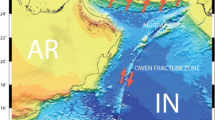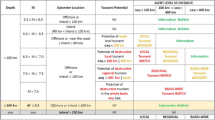Abstract
Coastal tsunami amplitudes were calculated to identify areas susceptible to tsunami hazard at selected locations of the coast of Karnataka, west of India, due to earthquakes in the Makran Subduction Zone. This is the first time that the probabilistic tsunami hazard assessment along this study area has been attempted. A series of earthquake source scenarios with magnitudes of Mw 8.0, Mw 8.5, and a mega thrust of Mw 9.1 were modeled by using the Community Model Interface for Tsunami interface with the MOST model of Titov and Synolakis (J. Waterway, Port, Coastal and Ocean Engineering, 121(6), 308–316, 1995). As per the previous occurrences, the two least magnitudes are probable, while Mw 9.1 is a worst-case scenario as described by Heidarzadeh et al. (Ocean Engineering, 36(5), 368–376, 2009) and the same is reported by Burbidge et al. (Geoscience Australia Professional Opinion No. 2009/11) as high magnitude. These are not at all historical earthquakes or specifically from historical catalogues. The results of modeling show that all the seven coastal locations are inundated barely in our worst-case scenario with maximum water levels in the range of 100–200 cm. The first tsunami wave strikes the coast within 4–5 h of earthquake occurrence.






Similar content being viewed by others
References
Ambraseys, N. N., & Melville, C. P. (1982). A history of Persian earthquakes (pp. 89–90). New York: Cambridge University Press.
Aslam, B., Muhammad, J., Muhammad, Z.I., Gulraiz, A. & Quaid, I.A. (2017) GIS mapping of tsunami susceptibility: case study of the Karachi City in Sindh, Pakistan. Journal of Geography and Natural Disasters, 7(1). https://doi.org/10.4172/2167-0587.1000187.
Beer, A., & Stagg, J. M. (1946). Seismic sea-wave of November 27, 1945. Nature, 158, 63.
Bhat, H. G., & Subrahmanya, K. R. (2000). Shoreline changes and evolution of the coastal zone in southern Karnataka, India—an analysis based on multi-temporal data. International Archives of Photogrammetry and Remote Sensing, 33(B7), 191–197.
Burbidge, D.R., Cummins, P.R., Mleczko, R., Latief, H., Mokhtari, M., Natawidjaja, D., Rajendran, C.P. & Thomas, C. (2009). A probabilistic tsunami hazard assessment of the Indian Ocean nations. Geoscience Australia Professional Opinion No. 2009/11.
Byrne, D. E., Syke, L. R., & Davis, D. M. (1992). Great Thrust earthquakes and aseismic slip along the plate boundary of the Makran Subduction Zone. Journal of Geophysical Research., 97(b1), 449–478.
Dababneh, A.J., Ferguson, B. & Barton, D.J. (2012). Probable maximum tsunami due to an earthquake in the Makran subduction zone, Presented at ISOPE.
ETOPO1 2016. http://www.ngdc.noaa.gov/mgg/global/global.html
Hafeez, H. (2007). The potential of tsunami generation along Karachi and Makran coast of Pakishtan. Pakistan Journal of Meteorology, 4(7), 25–40.
Heidarzadeh, M. & Kijko, A. (2011). A probabilistic tsunami hazard assessment for the Makran subduction zone at the northwestern Indian Ocean, DOI https://doi.org/10.1007/s11069-010-9574-x.
Heidarzadeh, M., & Satake, K. (2014). New insights into the source of the Makran tsunami of 27 November, 1945 from tsunami waveforms and coastal deformation data. Pure and Applied Geophysics, 172, 621–640. https://doi.org/10.1007/s00024-014-0948-y.
Heidarzadeh, M., Pirooz, M. D., Zaker, N. H., & Mokhtari, M. (2007). Evaluating the potential for tsunami generation in southern Iran. International Journal of Civil Engineering, 5(4), 312–329.
Heidarzadeh, M., Pirooz, M. D., Zaker, N. H., & Synolakis, C. E. (2008). Evaluating tsunami Hazard in the Northwestern Indian Ocean. Pure Applied Geophysics, 165, 2045–2058.
Heidarzadeh, M., Pirooz, M. D., Zaker, N. H., Yalciner, A. C., Mokhtari, M., & Esmaeily, A. (2008a). Historical tsunami in the Makran subduction zone off the southern coasts of Iran and Pakistan and results of numerical modeling. Ocean Engineering, 35(8&9), 774–786.
Heidarzadeh, M., Pirooz, M. D., & Zaker, N. H. (2009). Modeling the near-field effects of the worst-case tsunami in the Makran subduction zone. Ocean Engineering, 36(5), 368–376.
Hoechner, A., Babeyko, A. Y., & Zamora, N. (2015). Probabilistic tsunami hazard assessment for the Makran region with focus on maximum magnitude assumption. Natural Hazards Earth System Science, 3, 5191–5208.
Hussain, J., Butt, K.A. & Pervaiz, K. (2002). Makran coast: a potential seismic risk belt, Geological Bulletin, University Peshawar, 35, 43–56.
Imamura, F. (2006). TUNAMI-N2 (Tohoku University’s Numerical Analysis Model for Investigation of Near Field Tsunamis version 2) Manual draft. http://www.tsunami.civil.tohoku.ac.jp/hokusai3/J/projects/manual-ver-3.1.pdf
Jaiswal, R. K., Rastogi, B. K., & Murty, T. S. (2008). Tsunamigenic sources in the Indian Ocean. Science of Tsunami Hazards, 27(2), 32–53.
Jaiswal, R. K., Singh, A. P., & Rastogi, B. K. (2009). Simulation of the Arabian Sea Tsunami propagation generated due to 1945 Makran Earthquake and its effect on western parts of Gujarat (India). Natural Hazards, 48(2), 245–258.
Mahmood, N., Khan, K., Rafi, Z. & Finn, L. (2012). Mapping of tsunami hazard along Makran coast of Pakistan, Technical Report No. PMD-20/2012, Pakistan Meteorological Department.
Mansinha, L., & Smylie, D. E. (1971). The displacement fields of inclined faults. Bulletin of the Seismological Society of America, 61(5), 1433–1440.
Mokhtari, M., Abdollahie Fard, I., & Hessami, K. (2008). Structural elements of the Makran region, Oman Sea and their potential relevance to tsunamigenisis. Natural Hazards, 47, 185–199.
Neetu, S., Suresh, I., Shankar, R., Nagarajan, B., Sharma, R., Shenoi, S. S. C., Unnikrishnan, A. S., & Sundar, D. (2011). Trapped waves of the 27 November, 1945 Makran tsunami: observations and numerical modeling. Natural Hazards, 59, 1609–1618.
Okada, Y. (1985). Surface deformation due to shear and tensile faults in a half-space. Bulletin of the Seismological Society of America, 75, 1135–1154.
Page, W. (1979). Evidence for the recurrence of large-magnitude earthquakes along the Makran Coast of Iran and Pakistan. Tectonophysics, 52(1–4), 533–547.
Papazachos, B. C., Scordilis, E. M., Panagiotopoulos, D. G., Papazachos, C. B., & Karakaisis, G. F. (2004). Global relations between seismic fault parameters and moment magnitude of earthquakes. Bulletin of the Geological Society of Greece, 36, 1482–1489.
Patanjali, C. K., Devi, E. U., Mahendra, R. S., Sunanda, M. V., Kumar, M. P. M., Padmanabham, J., Dipankar, S., & Kumar, S. T. (2015). The admissible tsunamigenic sources region of 24 September 2013 land-based earthquake—application of backward ray tracing technique. Current Science, 108(9), 1712–1716.
Patel, V. M., Dholakia, M. B., & Singh, A. P. (2013). Tsunami risk 3D visualizations of Okha coast, Gujarat (India). International journal of engineering science and Innovative Technology, 2(2), 130–138.
Pendse, C. G. (1948). The Makran earthquake of the 28 November, 1945. Science Notes, Indian Meteorological Department, 10, 141–144.
Rafi, Z. & Mahmood, N. (2010). Numerical modeling of tsunami inundation for potential earthquake at Makran Subduction Zone (a case study for Gwadar Coastal Area) Technical Report No. PMD-45/2010.
Rajendran, C. P., Ramanamurthy, M. V., Reddy, N. T. & Rajendran, K. (2008). Hazard implications of the late arrival of the 1945 Makran tsunami. Current Science, 95(12), 1739–1743.
Rao, N.P. (2007). Characterization of potential tsunamigenic earthquake source zone in the Indian Ocean, Tsunami and nonlinear waves, 285–312.
Seng, D.C. & Guillande, R. (2008). Disaster risk profile of the Republic of Seychelles, United Nations Development programme.
Sowmya, K., & Jayappa, K. S. (2016). Environmental sensitivity mapping of the coast of Karnataka, west coast of India. Ocean & Coastal Management, 121, 70–87.
Srinivasa, T.K, Nayak, S. & Guptha, H.K. (2014). India's tsunami warning system. In A. Ismail-Zadeh, J. Urrutia Fucugauchi, A. Kijko, K. Takeuchi, & I. Zaliapin (Eds.), Extreme Natural Hazards, Disaster Risks and Societal Implications(Special Publications of the International Union of Geodesy and Geophysics, pp. 322-330). Cambridge: Cambridge University Press. https://doi.org/10.1017/CBO9781139523905.032.
Srivastava, K., Dimri, V. P., Rani, V. S., Kumar, R. K., & Narain, L. (2011). Would Makran tsunami skip India? No it would reach 8 minutes later than Ratnagiri. Indian Journal of Geo-Marine Science, 40(5), 620–623.
SRTM (2016). http://srtm.csi.cgiar.org/ & http://srtm.usgs.gov/
Titov, V.V. (1997). Numerical modeling of long wave runup. Ph.D. thesis, University of Southern California, Los Angeles, California, 141 p.
Titov, V. V., & Synolakis, C. E. (1995). Modeling of breaking and nonbreaking long-wave evolution and runup using VTCS-2. J. Waterway, Port, Coastal and Ocean Engineering, 121(6), 308–316.
Wijesundara, W. A. A. P. (2014). GIS based tsunami risk assessment in Weligma, Sri Lanka. Universal Journal of Geoscience, 2(8), 242–250.
Zuhair, M., & Alam, S. (2017). Tsunami impacts on nuclear power plants along Western coast of India due to a great Makran earthquake: a numerical simulation approach. International Journal of Geosciences, 8, 1417–1426.
Acknowledgments
The first author thanks INCOIS for extending the facilities to carry out this work. She acknowledges the Department of Marine Geology, Mangalore University for the overall support.
Funding
This study was financially supported by the Department of Science and Technology, New Delhi, in the form of a Fellowship (DST/INSPIRE Fellowship/2013/364, dated16.08.2013).
Author information
Authors and Affiliations
Corresponding authors
Rights and permissions
About this article
Cite this article
K, S., Kumar, C.P. & Jayappa, K.S. The probabilistic tsunami hazard assessment along Karnataka Coast from Makran Subduction Zone, west coast of India. Environ Monit Assess 190, 679 (2018). https://doi.org/10.1007/s10661-018-7048-x
Received:
Accepted:
Published:
DOI: https://doi.org/10.1007/s10661-018-7048-x




